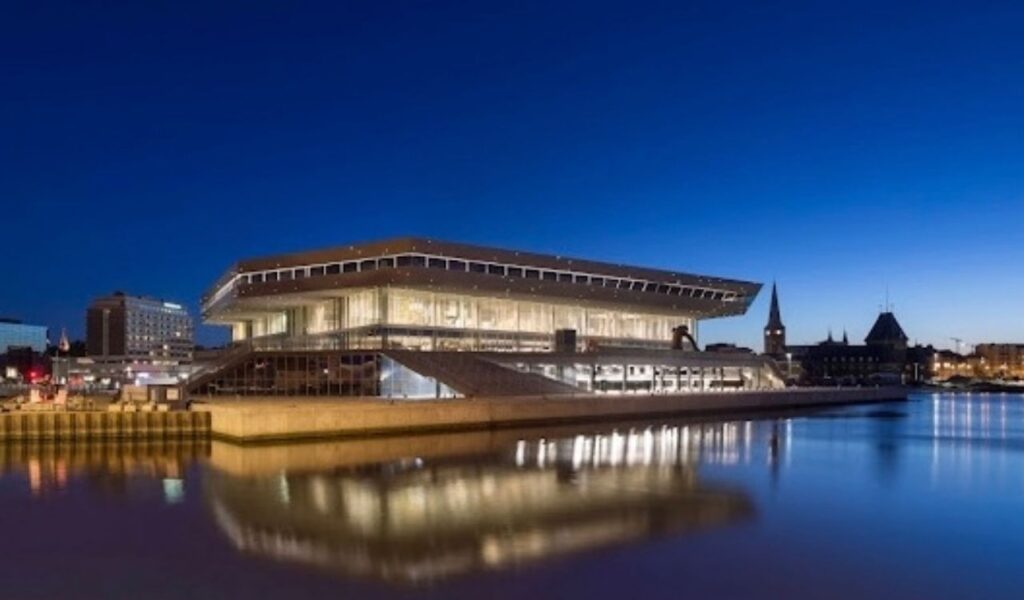If the Architecture of Aarhus isn’t already on your radar, it should be. Aarhus, a design lover’s oasis with historical buildings dating back to the 18th century, midcentury modern architecture, independent boutiques selling goods by local makers, and a massive new waterfront neighbourhood anchored by futuristic apartment buildings, was founded by the Vikings around 1,000 years ago.
Aarhus’ 2017 European Capital of Culture title resulted in a record-breaking 11.2 million overnight visitors, nearly 2,000 new employment, and a 159.1 million Euro increase in revenue for local businesses. Despite the fact that Aarhus and the central Danish region have seen enormous growth in recent decades, the European Capital of Culture has given us a huge boost that has rippled internationally.
The port town of Aarhus, which was created as a harbour hamlet on the banks of the river Aarhus, has grown from being one of Denmark’s fastest-growing commercial hubs to the country’s second-largest metropolis. It has seen it all, from early Christian churches to the stormy Viking era, and has steadily regenerated itself from the ravages of political and geographic forces, dating back to the early eighth century when the port city of Aarhus was christened Aros, which means “the mouth of the river.”
Whilst people of Aarhus endured constant wars and plagues during the 1600s, trade took a back seat, and Copenhagen became the centre of power. The Industrial Revolution, on the other hand, brought with it an opportunity for economic and cultural resurrection, which fuelled rapid population expansion, outperforming regional rivals and allowing Aarhus to climb above its status as Copenhagen’s “poor cousin.”
Table of Contents
History
Architecture of Aarhus: The Viking Age
Aarhus is one of Denmark’s oldest cities, with a Viking era that dates back to the early eighth century, but virtually little of it survives now. The town, which comprised of wooden dwellings known as “Pit Houses” and “Longhouses,” was centred on the bank of a fjord at the mouth of the river Aarhus.
To safeguard the town from recurrent invasions and political strife, the pristine old town was fortified with mud ramparts and a moat. With the fjord to the south and the coast to the east, the moat surrounds the present-day Aarhus Cathedral and Store Tory.
The amazing constructions like St. Nicholas Church, St. Olaf’s Church, and the wooden Christian cemetery were built using wood, which was the primary building material during the Viking era, that traced the impact of Viking city’s culture.
The Middle Ages and Aarhus
During the early and mid-12th centuries, the Church’s expanding power converted Aarhus, along with its bishopric, into a flourishing religious centre. The Church had the upper hand when planning out the construction of a new city during much of the thirteenth century in what was originally known as Aros, with the Church having the upper hand while laying out the structure of a new city. The majority of churches and civic buildings constructed at this time were Romanesque in design.
With lavishly ornamented pedestals, motifs, and rounded arches, the Church of Our Lady and the Aarhus Cathedral are two of the most well-known examples of Danish Romanesque architecture from the Middle Ages. However, in the latter centuries of the mediaeval era, most Romanesque churches were transformed into Gothic structures.
The St. Clements Cathedral in Aarhus was converted to a “hall church” form in the mid-1400s, with rib vaults added to the choir and nave. The Romanesque rounded arches were replaced with Gothic pointed arches, and the steeple roof was made Octagonal, all of which were typical of Danish Gothic architecture at the time.
The city of Aarhus regained its commercial prominence in the late 1400s, during which time spatial growth accelerated and moats and ramparts were repurposed and destroyed to meet the increase in people. The flaming Renaissance movement throughout Europe influenced the formative years from the early 1500s until the mid-1800s, with Aarhus being renovated as a “Market Town.”
Merchants flocked to Immervald and the eastern side of Vestergaard, resulting in a new wave of peripheral districts such as Studsgade and Mejlgade, as well as the primary entrance points to the old market place. This was also the beginning of the era of aristocracy and prosperity, as well as the transition from timber-framed to brickwork construction, but it was still a small town and Aarhus had a scarcity of large-scale structures in the 18th century.
The Ascension of National Romanticism
Between the late 1800s and the mid-1900s, Denmark experienced a period of nationalism that culminated in an elaborate representation of the Art Nouveau variant National Romanticism in Aarhus, which was defined by the use of indigenous materials such as brick, limestone, and granite.
The Aarhus Customs House, erected in 1898, the old State Library, built in 1902, and the Aarhus Theatre, completed in 1900, are the architectural highlights of Aarhus’ National Romanticism. Many public schools were built in Aarhus at this time. Hack Kampmann’s “red building” of the Aarhus Cathedral School was a prime example of National Romantic School architecture.
This popular design style was frequently combined with other styles of the time to create an innovative design vocabulary. The Aarhus Fire Station, which fused National Romanticism and Renaissance Revival in 1904, and the Ole Rmer Observatory, which incorporated the Arts and Crafts Movement in 1911, are two of the best examples of this fusion.
The Age of Hack Kampmann and Nordic Classicism
The wildly popular period of National Romanticism was followed by a period of Neoclassicism, which was characterised by precision, reasoning, and artistic collaboration, with the Danish architect Christian Frederik Hansen as its mascot, as a reaction to the decorative and deeply ornamental styles that preceded it. The new generation of architects was concerned with socio-political concerns and tried to create more affordable and appealing communities, institutions, and architecture.

Hack Kampmann, a renowned Danish architect, was a leading proponent of National Romanticism until the 1920s, when he switched to Neoclassicism and became one of its key pioneers. He came in Aarhus in 1892 and was responsible for the construction of a number of big, monumental public structures, notably the Royal Family’s vacation house, the Marselisborg palace, which was completed between 1899 and 1902. The Aarhus Theatre and the Danish National Business Archives are just a couple of Kampmann’s other prominent work in Aarhus.
Place with Historical Significance
Taking A Stroll Through Møllestien
The charming cobblestone lane in the heart of Aarhus, with hollyhocks and wild roses climbing against little ancient half-timbered houses, oozes old-world charm and dates from the early Middle Ages. The beautiful Mllestien’s unique dwellings, known as “outhouses” or “booths,” were erected in the 1700s and are generally one-story with an aperture or a window, making them the ideal vacation to bygone Danish days.
The Historic Town: Den Gamle By
From 1864 until 1974, the ancient town of Aarhus known as “Den Gamle By” is a national open-air “living” museum of Danish urban history and culture. Den Gamle By’s streets depict the Danish way of life throughout the centuries, not just via impeccably kept buildings and ethos, but also through people’s clothes and atmosphere.
From the sidewalk and cobblestone roads to the interiors, people’s lifestyles, and authentic Danish spirit, walking through the streets transports you back in time. The pathways are lined with traditional relocated dwellings, parlours and salons, stores and businesses, as well as a schools, post office, telephone exchange, and jazz bar in their natural state, unaffected by the drastically futuristic surrounds.
A New Era Of Danish Functionalism
The Stockholm Exhibition
The Stockholm exhibition of 1930 had a huge impact on Danish architectural expression, opposing historicist principles and paving the way for a new type of design known as Functionalism. With the rising concept of mass production in construction, the use of decoration and ornamentation was reduced to a minimum and was replaced by an emphasis on materials to reflect modern lifestyle through form, function, and technology.
The University Of Aarhus

The University of Aarhus, designed by C.F. Mller, Kay Fisker, and Povl Stegmann in 1933, is one of the most prominent examples of Danish Functionalism on the list of architectural landmarks in Aarhus and is included in the Danish Culture Canon.
Aarhus City Hall
Another prominent example of Functionalism is the Aarhus City Hall, designed by Arne Jacobsen and Erik Mller in 1941. With its blue-green marble façade and distinctive clock tower, it is one of the city’s most recognisable sights.
Architecture of the Modern, Post-Modern and Contemporary Periods in Aarhus
Nordic architecture has been directed by a dialogue between modernity and tradition since the Second World War, motivated by a mutual respect for their local environment and social customs. Since the 1960s, Aarhus has served as a testing ground for aspiring architects and designers, who have made their mark on the city with a wide range of architectural styles inspired by global modernist icons.
Many global architectural titans have their headquarters in Denmark, including BIG, C.F. Mller Architects, Schmidt Hammer Lassen, and others. They made a substantial contribution to Aarhus’ modernist and contemporary skyline. The Musikhuset Aarhus, designed by Kjr & Richter, and the Henning Larsen Architects-designed Moesgrd Museum in Aarhus are two instances of modernist architecture.
Contemporary architecture in Denmark at the turn of the century prioritised the optimal use of natural light, sustainable energy systems, and building a pleasant environment, but with distinctive shapes and geometry, making it popular around the world.
With their futuristic and interesting designs, the irregular Isbjerget (iceberg), a unique Architectonic treasure in the middle of the city, and the new public library, Dokk1, are two of the most remarkable instances of Contemporary architecture in Denmark.
One example is the Schmidt Hammer Lassen-designed ARoS Aarhus Kunstmuseum, which is the city’s principal destination and one of Scandinavia’s largest museums. The unique Olafur Eliasson glass ring on the roof, which offers a colourful panorama of the city, is one of the primary sights here.

But Aarhus (also known as Aarhus Island), a new community on what Mayor Bundsgaar describes as “Aarhus’ most appealing development site,” is the largest and most ambitious project. It includes an AD100 firm Bjarke Ingels Group’s futuristic apartment building and Harbor Bath, as well as Cebra’s Iceberg housing complex. Several other buildings, including a new hotel, are still under construction.
The number of notable examples across Aarhus is endless, ensuring that it lives up to its nickname of “the City of Smiles” and serves as an architectural jewel on the outskirts of Continental Europe. With a blend of Nordic old-world charm and stark modernist harshness, Aarhus is one of the top destinations for architectural connoisseurs across the world, and provides something for everyone, be it history enthusiasts or tech geeks.






